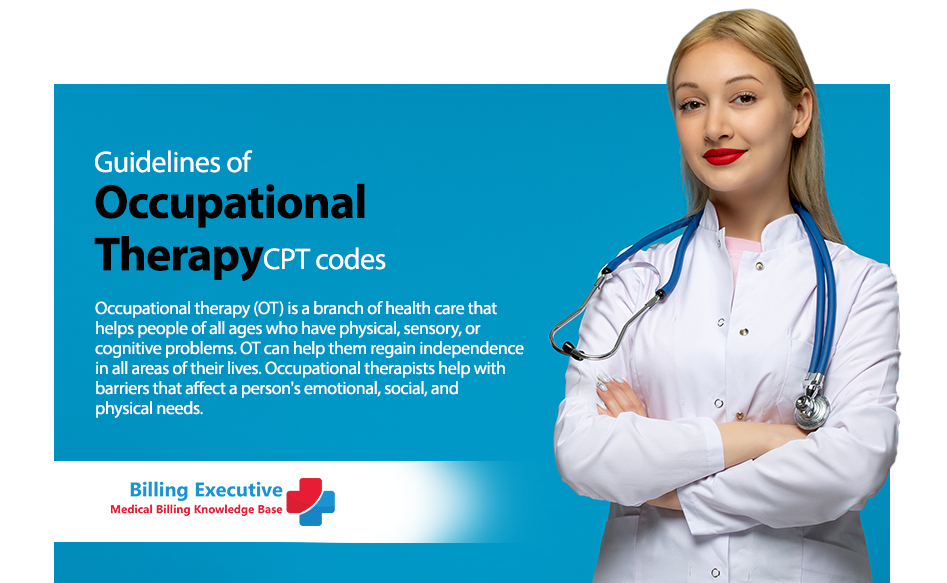There are different occupational therapy ICD-10 codes, knowing which to use when assessing and treating patients. We’ll wrap up with a list of the most common ICD-10 codes used by occupational therapists.

What Are Occupational Therapy CPT codes?
The American Medical Association created the CPT code, which stands for Current Procedural Terminology code. These codes define the products and services you provide as an occupational therapist seen on insurance claims you submit to your insurer.
If your practice is entirely private pay, you must still use CPT codes on a superbill if your client intends to seek reimbursement from their medical insurance carriers.
What Does An Occupational Therapy Evaluation Entail?
The following are typical components of an occupational therapy evaluation:
- An occupational profile: It is a personalized assessment of a patient’s occupational history and experiences, as well as daily living patterns, preferences, values, and necessitates. That is accomplished in collaboration with the client/family and the occupational therapist.
- History Of Patient: The patient’s medical and therapy history.
- Clinical decision making: A tailored intervention to boost the patient’s ability to carry out daily tasks and achieve specific objectives.
- Plan of care development: An outcome evaluation to ensure goals are met and modify the intervention plan based on emerging data.
CPT Codes For Ten Common Occupational Therapy Therapeutic Procedure Treatments
While hundreds of CPT treatment codes are available, occupational therapists frequently use the following ten.
- CPT code 97110: Therapeutic exercises are workouts and activities specifically designed to assist patients in improving their mobility and fitness levels. CPT code 97110 refers to fundamental occupational therapy activities that help patients to increase their strength and range of motion
- CPT code 97112: Mobility, balance, synchronization, kinesthetic awareness, form, and proprioception neuromuscular re-education for sitting and standing operations.
- CPT code 97113: Aquatic Therapy with Therapeutic Exercises (CPT code 97113) (one or more areas, every 15 minutes)
- CPT code 97530: Therapeutic Activities, direct patient contact in every 15 minutes This code refers to a wide range of rehabilitative procedures such as stretching, lifting, holding, reaching, catching, transferring, and overhead activities to improve mobility, strength, balance, synchronization, and functional performance.
- CPT code 97140: It includes manual Therapy Techniques such as mobilization, manual lymphatic drainage, manual traction etc., in one or more regions, each 15 minutes
- CPT CODE 97150: It is vital to highlight that group therapy is not time-based and is reported individually for each member of the group).
- CPT code 97533: Approaches based on sensory integrative to increase sensory processing and encourage adaptive responses to environmental demands, direct (one-on-one) patient interaction, every 15 minutes.
- CPT code 97535: Self–care/home management training (e.g., activities of daily living (ADL) and compensatory training, meal preparation, safety procedures, and instructions in the use of assistive technology devices/adaptive equipment) direct one-on-one contact, each 15 minutes
- CPT code 97537: Training for Community/Work Reintegration such as shopping, transportation, money management, avocational activities, and job modification analysis, work task analysis 15 minutes of direct face to face contact
- CPT code 97542: It deals with the management of wheelchair for 15 minutes.
If you’re confused about choosing between CPTs, it’s advisable to get advice from your insurance company or your state occupational therapy board and association. The American Occupational Therapy Association (AOTA) also provides billing resources for OTs.
Billing recommendations for CPT codes for OTs
Here are three general guidelines to follow for CPT codes for OTs.
- If you’re an in-network provider visiting customers with insurance, do your homework ahead of time to determine which the client’s insurance company doesn’t cover codes.
- CPT code and reimbursement changes are frequently made on an annual basis. Keep up current on these updates by visiting the CMS website.
- The document which CPT codes you utilize during service rather than the following day. It might be tough to remember which codes to bill for each one when you have an increasing caseload. Furthermore, the sooner you file a claim, the better.
Reputable medical billing and coding businesses supply coders that understand how to use the appropriate CPT codes to report therapeutic operations, allowing practitioners to submit accurate claims and prevent denials.
About us
Billing Executive – a Medical Billing and Coding Knowledge Base for Physicians, Office staff, Medical Billers and Coders, including resources pertaining to HCPCS Codes, CPT Codes, ICD-10 billing codes, Modifiers, POS Codes, Revenue Codes, Billing Errors, Denials and Rejections.
We have more than 10 years experience in US Medical Billing and hand-on experience in Web Management, SEO, Content Marketing & Business Development with Research as a special forte.
Learn More
Guidelines for Chemotherapy Administration Coding
Medical billing basics for Ambulatory surgical centers
Understanding the Need of Botulinum Toxin Therapy
Understand the different types of Medical Specialties and Subspecialties
